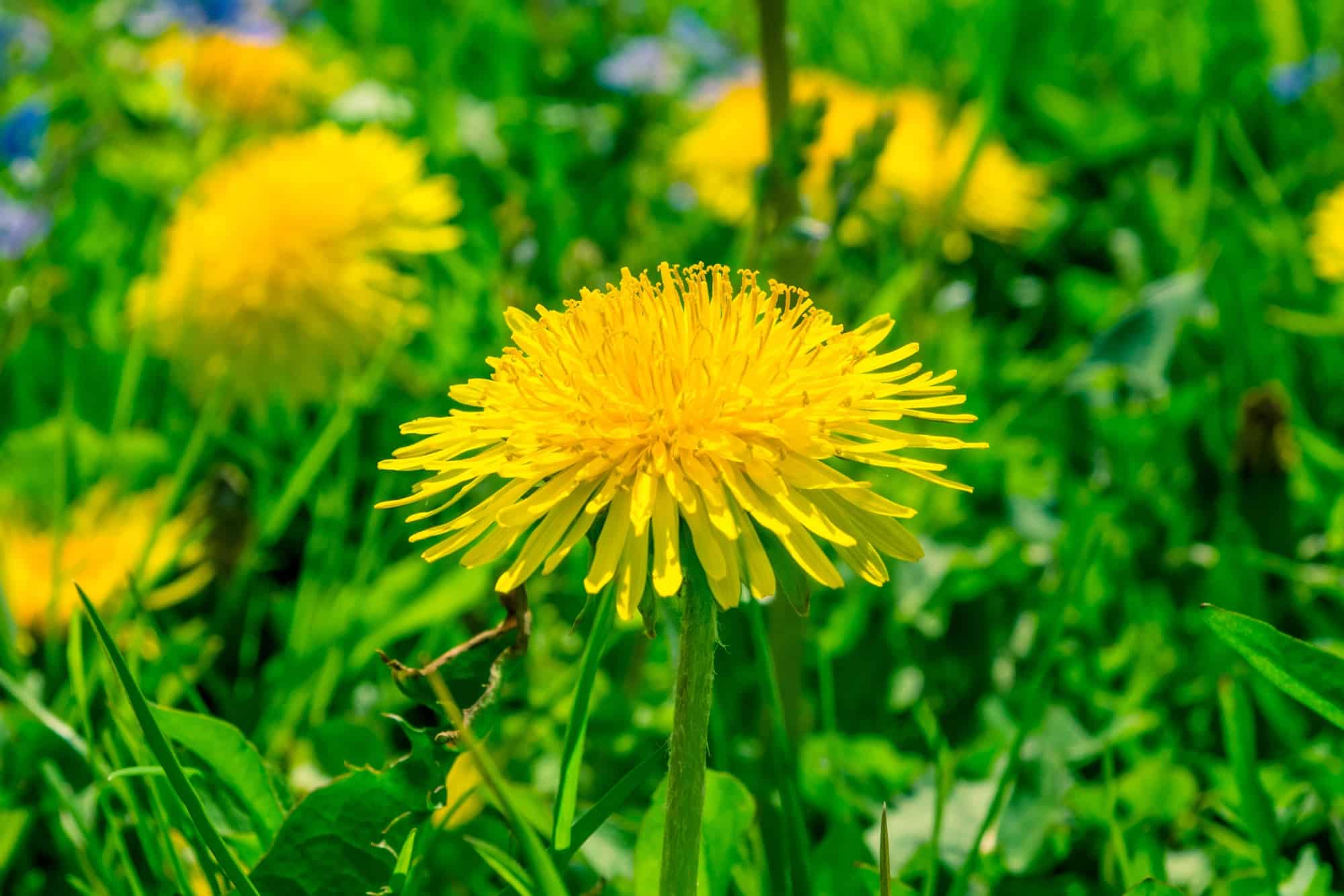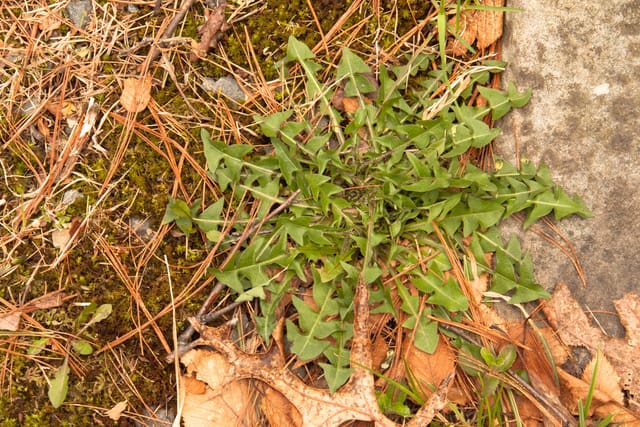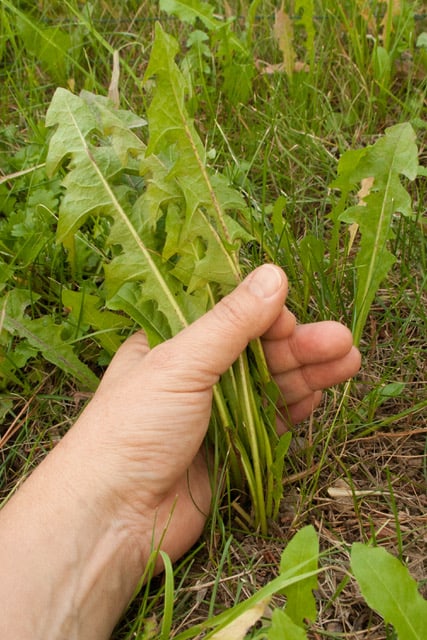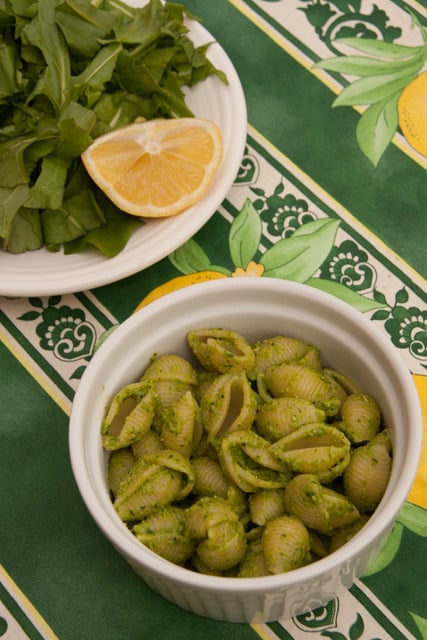
The world is divided into two kinds of people: dandelion haters and dandelion lovers. If you’re someone who’s interested in unique flavors, growing your own food, and creatively making the most of what you’ve got, you may already belong to the latter group. If so, you’re going to love this dandelion pesto.
But If you despise the dandelion, and spend time and money on its eradication, I suggest you seek revenge on this tenacious weed by eating it.
The truth about dandelion greens
Dandelion leaves are a classic bitter green, packed with minerals and vitamins. Don’t be put off by the word “bitter”. Lots of people pay good money for bitter greens like arugula, chicory, and endive. In small quantities, raw bitter greens liven up a salad, balanced with mild greens like cultivated lettuce or foraged chickweed.
Cool temperatures produce the tastiest, most tender dandelion greens, so look for them in early spring or late fall. Summer dandelion greens (especially those growing in full sun) are often too bitter for most people to enjoy raw. Instead, blanch the leaves for two to three minutes to remove some of the bitterness. Then use them in stir fries, soups, and egg dishes like frittatas, omelets, and quiches.
Blame the “Weeds” on the Colonists!
Dandelions aren’t native to North America; European colonists brought the seeds with them, because they valued the plant for its medicinal and culinary uses. Centuries later, we’ve forgotten all about its virtues. Today, most conversations about dandelions revolve around eliminating them.

In case you don’t know what dandelions look like (is that even possible?), here’s what you need to know to make a solid identification. Dandelions are perennial plants. They grow best in disturbed ground, like gardens and lawns. Dandelion leaves are arranged in a rosette and the size of this rosette varies according to growing conditions. In a dry, rocky spot, a dandelion may only be six inches in diameter. In your lawn or garden, with regular watering, they may be a foot across. Cultivated dandelion leaves sold at farmers’ markets or grocery stores are often eight inches long.
All dandelion leaves are toothed. The common name for the plant in several languages reflects this characteristic. In French it’s dent de lion, and in German it’s loewenzahn, both meaning tooth of the lion. These teeth are an essential identification factor for the dandelion; they point backward toward the center of the plant.
Dandelions produce one yellow flower per stem, and their stems are straight, never branched. A single plant may put up more than one stem, but each stem will never bear more than one flower at a time. Several dandelion look-alikes also produce yellow flowers, but they all have branching flower stems, and often produce multiple flowers simultaneously. Make sure to read The 10 Commandments of Edible Flowers before you pick any dandelions that you are planning to eat.
 How to Harvest Dandelion Greens
How to Harvest Dandelion Greens
To harvest your dandelion greens, grab the leaves at the base of the rosette with one hand, and hold them upright. With the other hand, use scissors to cut through the bunch of leaves, about an inch or two above the ground. Remember never to harvest close to busy roads, or in places where pesticides or herbicides may have been used, like golf courses or botanic gardens. And of course, wash your greens before cooking with them.
Now that you’ve got your dandelions, what will you do with them? How about an easy, tasty pesto recipe, perfect on pasta, rice, bruschetta, or stirred into soups to add a little herbal zip?
Dandelion Pesto Recipe
The flavor of dandelion greens shines in pesto. Its slight bitterness (remember, this is the good kind of bitter) combines well with cheese and nuts (or seeds, if you have a nut allergy). I make big batches when dandelions are in season, then freeze the sauce in half cup batches to use year ’round.
 Ingredients
Ingredients
1/4 cup olive oil
1/2 teaspoon salt
1/2 teaspoon pepper
3 cloves of garlic, peeled
6 cups dandelion greens, roughly chopped
1/2 cup of the nut or seed of your choice (pine nuts, black walnuts, and pepitas all work well)
1/2 cup grated romano or parmesan cheese
2 teaspoons lemon juice
Combine all the ingredients in your blender or food processor and press the on button. It’s that easy.
Start on low and gradually turn it up about halfway. I like a chunky pesto, but if you prefer yours silky smooth, go ahead and turn that dial all the way to high. Watch to make sure all the big chunks run through the blades. Then turn it off when you’ve reached the desired consistency.
Taste your dandelion pesto, and add more salt and pepper if needed. My husband and I don’t always agree on salt and pepper levels. That’s why I start with the minimum amounts (listed above) and let him add more to suit his taste.
This dandelion pesto freezes like a dream, and since the recipe makes enough for two pounds of pasta, you’ll have plenty to enjoy now and put aside for later.
————–
Ellen Zachos is the author of The Wildcrafted Cocktail and Backyard Foraging. Also read Ellen’s HG&H story about making a Blackberry Bramble Cocktail.



MY FATHER (FROM ITALY) PICKED DANDELIONS FOR YEARS AND I FOLLOWED SUIT. My oldest Son just sent me a photo from a Farmers Market in NY. of wild dandelion and they looked wonderful. Too bad companies like Dow and Monsanto gave dandelions a bad name and suggested that you should kill these WEEDS with poison (weed killer). It’s good to see a little more exposure about this wonderful spice that are called weeds– and they are FREE.